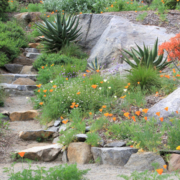Many San Diego County residents live near canyons, which are valuable natural resources. Native canyon hillsides should be not be disturbed.
When planting in previously disturbed or built slopes and hillsides, low-water plants, trees, deep-rooted native plant species, and climate-appropriate plants with strong root structures should be selected. Their powerful root systems can help hold the soil together.
If your slope is gentle with a 33 percent grade or less, coarse compost and mulch can be applied directly to hillside and slope surfaces. That will provide protection from rainfall and shade exposed soils. With occasional and gentle irrigation, mulch will “knit” together.
Compost blankets are another type of erosion control mat applied that can protect and preserve soil surfaces. They can be used alone, with coir mats or other organic-engineered material with biodegradable grids for stabilization. Mats allow water to penetrate to the underlying soils while retaining loose soil and debris, preventing erosion. You can plant right through them, or use pre-seeded products.
Hillside irrigation tips
When preparing a hillside for planting, determine how you plan to irrigate before doing any work. Low-volume rotating spray heads are ideal for sloped areas, if the space is large and the groundcover is uniform. Inline emitter drip tubing can also be effective, especially for shrubs and trees spaced farther apart.
Water can be applied in repeated short periods during any given day, so that it can be fully absorbed between applications. Runoff, erosion and efficient deep watering are always important issues to keep in mind, but especially on hillsides.
NOTE: When using a drip irrigation system, emitters should be placed above the plant basin. Spray systems should have check valves in all lower heads to avoid low point runoff. Irrigation for the top of the slope and bottom of the slope should be on separate valves.
This article was inspired by the 71-page Sustainable Landscapes Program guidebook available at SustainableLandscapesSD.org. The Water Authority and its partners also offer other great resources for landscaping upgrades, including free WaterSmart classes at WaterSmartSD.org.



